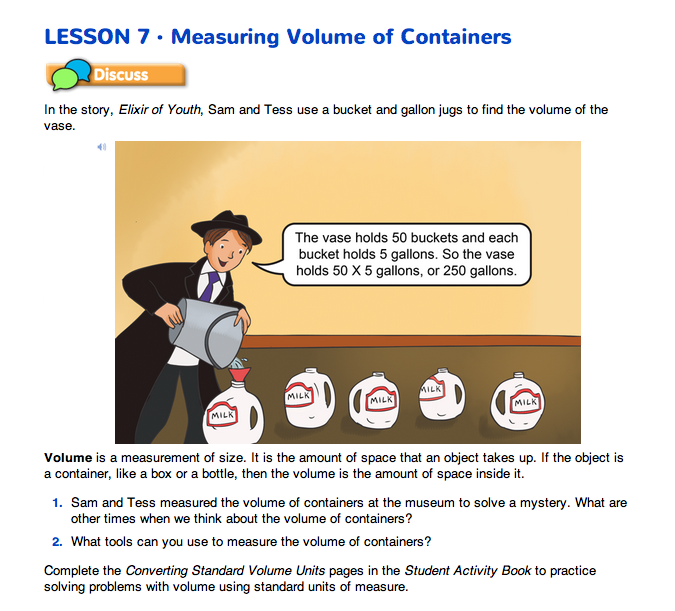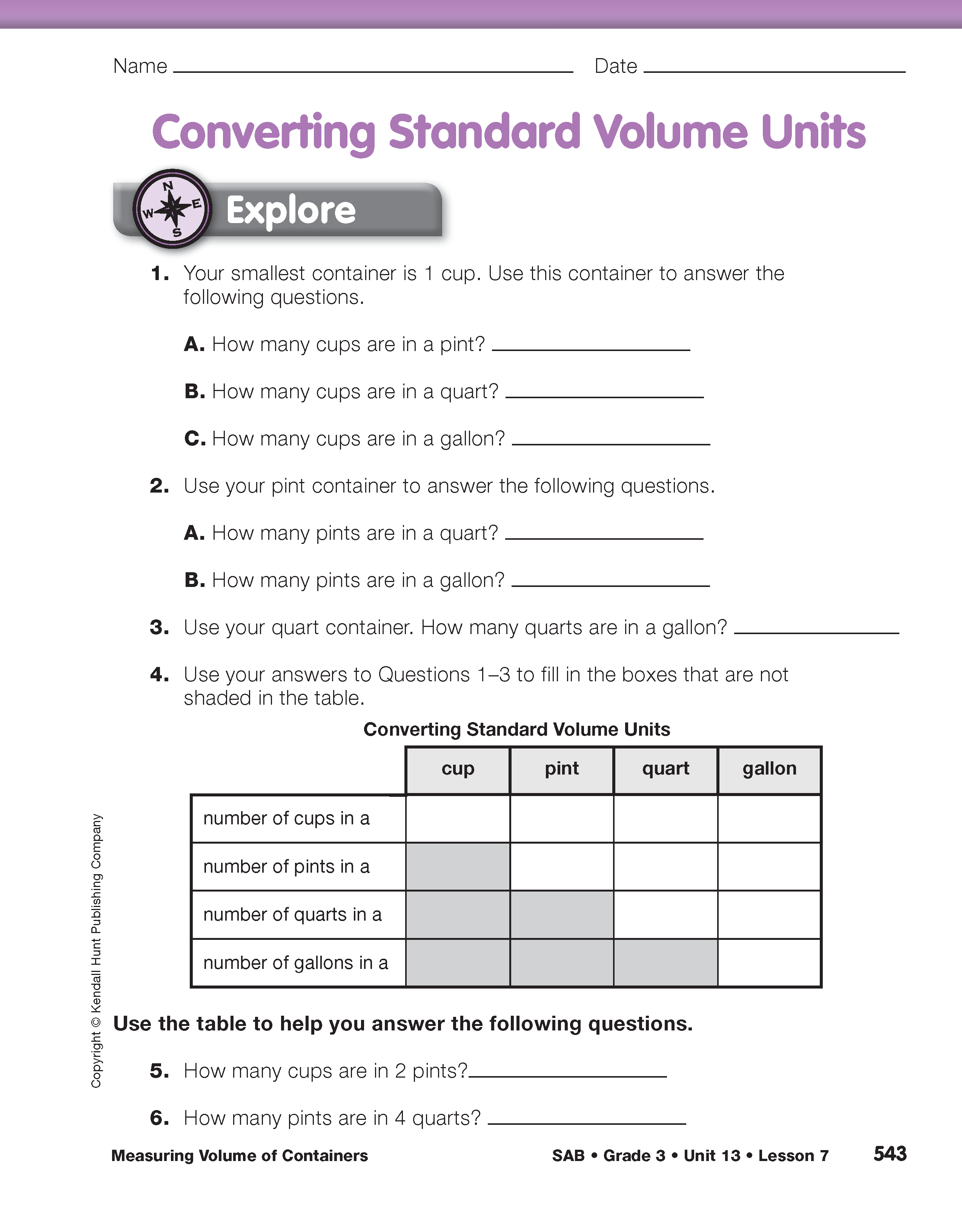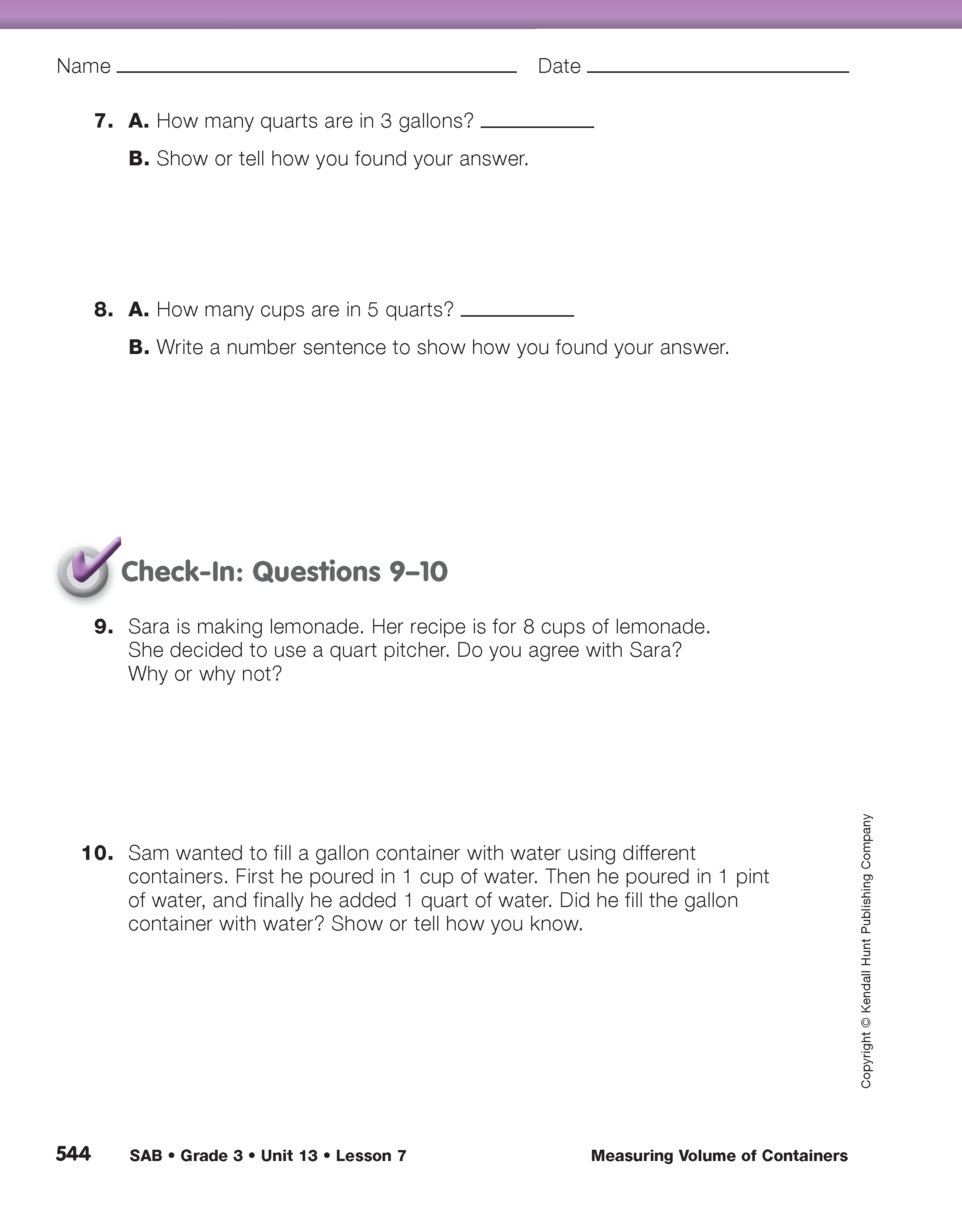Define Volume. Use the first Measuring the Volume of Containers page in the Student Guide to introduce this lesson. The picture on that page shows Sam using gallon jugs to find the volume of a bucket. He then uses this information to find the volume of the vase that held the elixir. Ask students to look back at the story in Lesson 6 Elixir of Youth. Find other examples in the story where Sam and Tess used volume. For example, Sam and Tess used the volume of the gas tank to decide how many miles the car can drive per gallon. They also used volume to find out how many small bottles can be filled with the elixir from each gallon. After students have had time to talk about the way Sam and Tess used volume to solve the mystery at the museum, read the definition of volume. See the Content Note for more information about volume.

Volume and Capacity. We use the term volume to define both the amount of space inside a container (capacity) and the amount of space taken up by a solid object.
U.S. standard volume units for capacity include, but are not limited to, cups, pints, quarts, and gallons. Metric units for capacity include, but are not limited to, cubic centimeters, milliliters, and liters.
Standard units of volume for a solid object are expressed in terms of length units such as cubic inches, cubic feet, cubic centimeters, and cubic meters. (Van De Walle, J., Karp K., and Bay Williams, J. Elementary and Middle School Mathematics, Eighth Edition, 2013)
Have students discuss Questions 1–2 with a partner. After students have had time to talk together, ask them to share their discussions. As a result of the discussion of Question 1, students should recognize that containers come in many shapes and sizes and that different size containers hold different amounts or have different volumes. For Question 2, students may identify specific tools to measure volume, such as a measuring cup or a teaspoon. They may identify both standard measuring tools, such as cups or quarts, and metric measuring tools. They may also identify non-traditional tools such as buckets, glasses, and bottles.
If students need help with this discussion use these or similar discussion prompts:
- When you go into a restaurant and order something to drink you may be asked if you want a small, medium, or large drink. What is the difference between each of these choices? (Possible response: They are all different sizes and hold different amounts of the drink you ordered.)
- If you go to the store to buy milk or juice what do you notice about the containers they are in? (Possible response: They come in different sizes and sometimes they are made of different things, like glass, plastic, or paper cartons. You can buy a gallon of milk or juice or you can get a smaller size like a quart or half-gallon. You can also buy very small containers like juice boxes for just one person.)
- Think about other containers you have seen at home or in a grocery store. What are other examples of containers that come in different sizes? (Possible response: Sometimes you can buy something in different-size cans or boxes. For example, you can buy a large family-size can of soup, or a large family-size box of macaroni to feed a whole family or you could buy a small can of soup or box of macaroni for just one or two people.)
- What are some other times when we measure volume of a container? (Possible responses: When you put gas in the car you need to know how many gallons of gas your car will hold. When you are baking or cooking you may need to know how many cups of an ingredient you have to add to the recipe. If you are taking medicine you need to know how many teaspoons or tablespoons you need to take.)
- What are some tools that you can use to measure volume? (Possible responses could include: cups, teaspoons, tablespoons, pints, quarts, gallons, graduated cylinders, buckets)
After students have completed this discussion ask them to restate what they have learned so far about measuring the volume of containers. Listen to make sure students understand that when you measure the volume of a container you are measuring how much a container can hold; learning that different-size containers have different volumes, and that you can use many tools to measure volume.
Measure Volume Using Cups, Pints, Quarts, and Gallons. Students will work in small groups for this activity. Each group will need a dishpan or similar container; a collection of four different-size containers that includes a cup, pint, quart, and gallon; several paper towels; a source for water; and the Converting Standard Volume Units pages from the Student Activity Book. See Materials Preparation.
You may want groups to work with their containers, graduated cylinders, water, and cups inside a dishpan that would collect any spills.
If water is not readily available or if you do not want to use water for this activity, you can use rice, small dried beans, or sand to compare the volume of each container.
Explain to students that although most scientists use the metric system of measurement, people in the United States still frequently use the U.S. customary system. Display the Converting Standard Volume Units page. Tell students that in this activity they will discover the relationships between four of the U.S. customary units: the cup, the pint, the quart, and the gallon.
Before students begin the exploration have them line up their four containers from smallest to largest and make sure they are able to identify the size of each container.
- What do you notice about your containers? (Possible response: They are different sizes and different shapes.)
- Compare your containers with those from a different group.
Have each student group use their collection of containers to complete Questions 1–8. Remind students to round their answers to the nearest whole number.
Discuss Solution Strategies. After each group has an opportunity to work on Questions 1–8, have students share their work. As students share their answers for Question 4 record their answers on the display of the Converting Standard Volume Units page.
After completing the spaces of the chart that are not shaded, encourage students to find the numbers that go in the shaded boxes in the table. Use these or similar prompts to begin a discussion, and have students fill in the appropriate shaded boxes with each question.
- If a pint will hold two cups, how many cups will it take to fill 1/2 of a pint? (1 cup. So 1/2 of a pint is equal to 1 cup.)
- If a quart will hold two pints, how many pints will it take to fill 1/2 of a quart? (1 pint is 1/2 of a quart.)
- How many cups are in a quart? (four)
- If there are four cups in a quart, how much of quart will you fill with one cup? (One cup will fill 1/4 of a quart.)
- Look at the boxes in the table that you have filled in so far. What patterns do you notice? (Possible response: All the numbers in the boxes that are shaded are fractions. You can find the fractions by looking at the numbers in the boxes that are not shaded; for example, if there are two cups in a pint then a cup is equal to 1/2 of a pint. If there are four cups in a quart then one cup is equal to 1/4 of a quart.)
- Use these patterns to fill in the shaded boxes for the gallon. How many gallons are in one quart? (1/4) In one pint? (1/8) In one cup? (1/16)
Ask students to share their solution strategies for Questions 5–8. Refer to the display of the Converting Standard Volume Units page, as needed to guide the discussion.
If a variety of strategies is not represented, use prompts similar to these to facilitate the discussion:
- How can you use a picture to figure out how many cups are in 2 pints? (Possible response: I drew a picture of two pint containers. Under each of the pint containers I drew 2 cups since there are two cups in each pint. I drew a total of 4 cups.)
- How can you use skip counting to find out how many pints are in 4 quarts? (Possible response: There are 2 pints in each quart so I counted by 2s four times: 2, 4, 6, 8, and found 8 pints in 4 quarts.)
- How can you use addition to find how many quarts there are in 3 gallons? (Possible response: I added 4 quarts + 4 quarts + 4 quarts = 12 quarts in 3 gallons. I added 4 quarts three times, once for each gallon.)
- How can you use multiplication to find out how many cups are in 5 quarts? (Possible response: 4 cups per quart × 5 quarts = 20 cups)
Assign Check-In: Questions 9–10 to students to complete independently. As students work, encourage them to use the chart they completed in Question 4 or the display of the completed table on the Converting Standard Volume Units page as a resource.
Use Check-In: Questions 9–10 on the Converting Standard Units of Volume page in the Student Activity Book to assess students' abilities to use the relationship between larger and smaller units of measure to solve problems [E9].


















